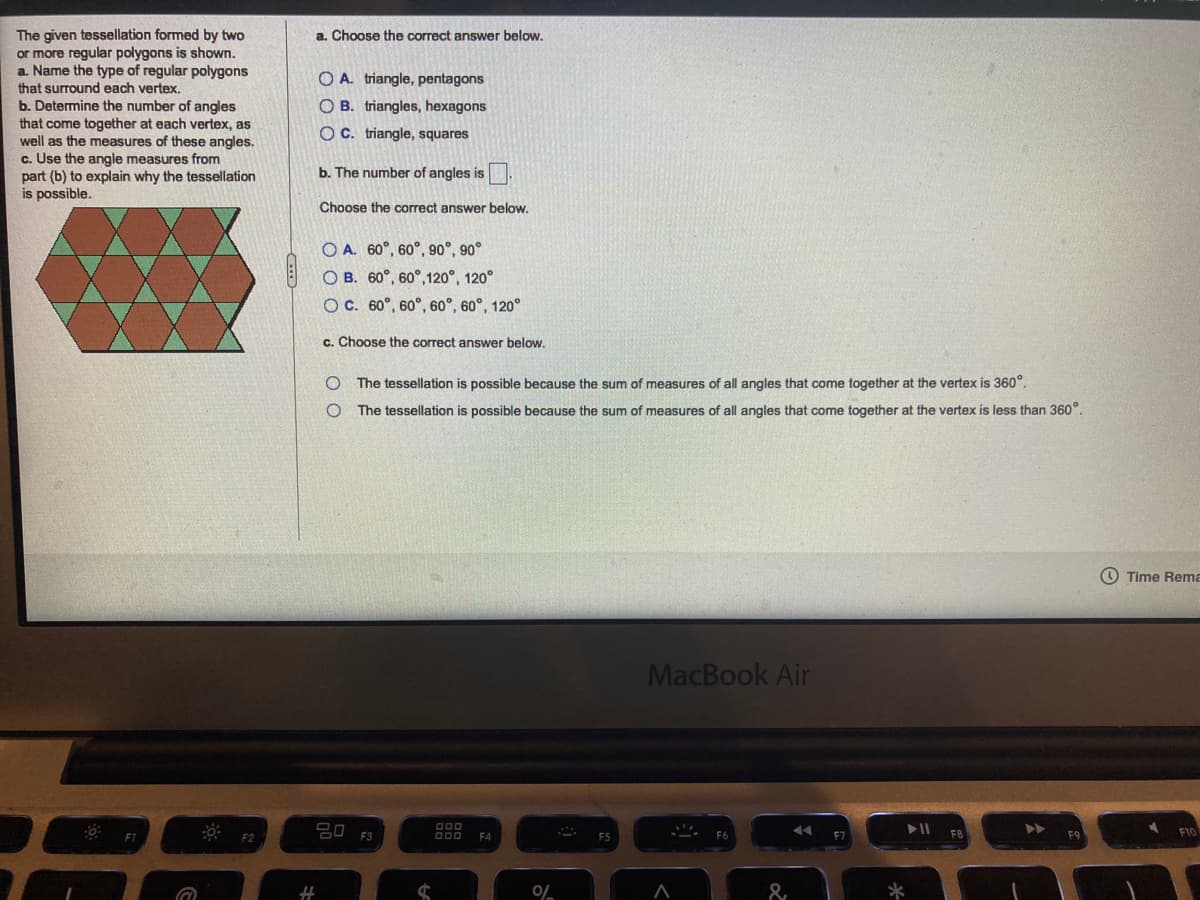The given tessellation formed by two or more regular polygons is shown. a. Name the type of regular polygons that surround each vertex. b. Determine the number of angles that come together at each vertex, as well as the measures of these angles. c. Use the angle measures from part (b) to explain why the tessellation is possible. a. Choose the correct answer below. O A. triangle, pentagons O B. triangles, hexagons OC. triangle, squares b. The number of angles is. Choose the correct answer below. O A. 60°, 60°, 90°, 90° O B. 60°, 60°,120°, 120° OC. 60°, 60°, 60°, 60°, 120° c. Choose the correct answer below. The tessellation is possible because the sum of measures of all angles that come together at the vertex is 360°. The tessellation is possible because the sum of measures of all angles that come together at the vertex is less than 360°. O O
The given tessellation formed by two or more regular polygons is shown. a. Name the type of regular polygons that surround each vertex. b. Determine the number of angles that come together at each vertex, as well as the measures of these angles. c. Use the angle measures from part (b) to explain why the tessellation is possible. a. Choose the correct answer below. O A. triangle, pentagons O B. triangles, hexagons OC. triangle, squares b. The number of angles is. Choose the correct answer below. O A. 60°, 60°, 90°, 90° O B. 60°, 60°,120°, 120° OC. 60°, 60°, 60°, 60°, 120° c. Choose the correct answer below. The tessellation is possible because the sum of measures of all angles that come together at the vertex is 360°. The tessellation is possible because the sum of measures of all angles that come together at the vertex is less than 360°. O O
Elementary Geometry For College Students, 7e
7th Edition
ISBN:9781337614085
Author:Alexander, Daniel C.; Koeberlein, Geralyn M.
Publisher:Alexander, Daniel C.; Koeberlein, Geralyn M.
Chapter6: Circles
Section6.4: Some Constructions And Inequalities For The Circle
Problem 39E: In O, chord AB chord CD. Radius OE is perpendicular to AB and CD at points M and N, respectively. If...
Related questions
Question

Transcribed Image Text:The given tessellation formed by two
or more regular polygons is shown.
a. Name the type of regular polygons
that surround each vertex.
b. Determine the number of angles
that come together at each vertex, as
well as the measures of these angles.
c. Use the angle measures from
part (b) to explain why the tessellation
is possible.
a. Choose the correct answer below.
O A. triangle, pentagons
O B. triangles, hexagons
OC. triangle, squares
b. The number of angles is.
Choose the correct answer below.
O A. 60°, 60°, 90°, 90°
O B. 60°, 60°, 120°, 120°
O C. 60°, 60°, 60°, 60°, 120°
c. Choose the correct answer below.
The tessellation is possible because the sum of measures of all angles that come together at the vertex is 360°.
The tessellation is possible because the sum of measures of all angles that come together at the vertex is less than 360°.
O Time Rema
MacBook Air
20 F3
F8
%23
оо
Expert Solution
This question has been solved!
Explore an expertly crafted, step-by-step solution for a thorough understanding of key concepts.
This is a popular solution!
Trending now
This is a popular solution!
Step by step
Solved in 2 steps with 1 images

Recommended textbooks for you

Elementary Geometry For College Students, 7e
Geometry
ISBN:
9781337614085
Author:
Alexander, Daniel C.; Koeberlein, Geralyn M.
Publisher:
Cengage,

Elementary Geometry for College Students
Geometry
ISBN:
9781285195698
Author:
Daniel C. Alexander, Geralyn M. Koeberlein
Publisher:
Cengage Learning

Holt Mcdougal Larson Pre-algebra: Student Edition…
Algebra
ISBN:
9780547587776
Author:
HOLT MCDOUGAL
Publisher:
HOLT MCDOUGAL

Elementary Geometry For College Students, 7e
Geometry
ISBN:
9781337614085
Author:
Alexander, Daniel C.; Koeberlein, Geralyn M.
Publisher:
Cengage,

Elementary Geometry for College Students
Geometry
ISBN:
9781285195698
Author:
Daniel C. Alexander, Geralyn M. Koeberlein
Publisher:
Cengage Learning

Holt Mcdougal Larson Pre-algebra: Student Edition…
Algebra
ISBN:
9780547587776
Author:
HOLT MCDOUGAL
Publisher:
HOLT MCDOUGAL